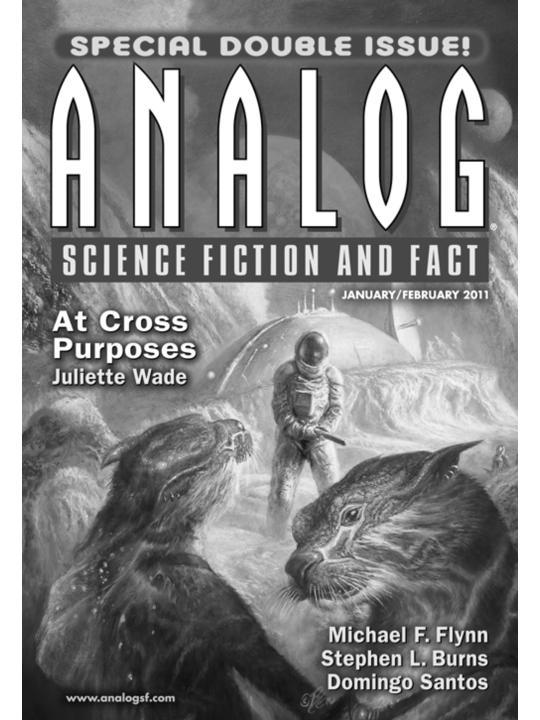Analog Science Fiction and Fact 01/01/11 by Dell Magazines

Author:Dell Magazines
Language: eng
Format: mobi, epub
Publisher: Dell Magazines
Published: 2011-01-01T08:00:00+00:00
Science Fact
Other Earths in Space and Time
Kevin Walsh
Right now, we don’t know of any other Earths, but we will soon. Worlds only slightly more massive than Earth have already been detected, and smaller planets will soon be found, orbs the size of Earth with similar temperatures and atmospheres. In the meantime, it is useful to consider what kind of...
Top of Science Fact
Novelettes Short Stories
Science Fact
Other Earths in Space and Time
Kevin Walsh
Right now, we don’t know of any other Earths, but we will soon. Worlds only slightly more massive than Earth have already been detected, and smaller planets will soon be found, orbs the size of Earth with similar temperatures and atmospheres. In the meantime, it is useful to consider what kind of places these other Earths could be, partly out of sheer scientific curiosity but also for more practical reasons. A clearer definition of the characteristics of Earth-like worlds will better enable them to be detected, as it would help astronomers narrow down the stellar systems where they should search for them. This is important, as the number of potential stellar systems to be examined is very large. Even if we confine ourselves to the relatively small region within 100 parsecs of the Sun, in this volume of the galaxy there are still about 40,000 Sun-like G stars, as well as several hundred thousand fainter stars that could host an Earth-like planet under certain circumstances. This is a lot of territory by anyone’s standards, and the quicker it can be explored, the better.
Of course, the term “Earth-like planet” is almost a misnomer. Here, we restrict the discussion to planets with approximately the same amount of incident solar radiation as Earth, planets within the so-called habitable zone. Outside of the habitable zone, there are certain to be plenty of Earth-sized planets, as the recent discovery of super-hot super-Earths has shown. But despite the huge number of possible planets even in the nearby part of the galaxy, we will probably not find a very close equivalent to the Earth for some time, because the number of variables that can modify or restrict planetary habitability is just too great. And even the term “habitable” means different things, depending on its application.
One definition would require an evaluation of a planet on the basis of the level of technology required to maintain human life on its surface. For instance, Earth is people-friendly, with a large portion of its surface having temperatures that do not depart too far from the human optimum of 22°C (72°F). It also possesses an eminently breathable atmosphere at sea level. Remove the oxygen from the atmosphere and Earth would still be relatively friendly, but we would need oxygen masks to survive and so the planet would be less habitable for humans. Many microbes, though, wouldn’t notice the difference.
Increase the rate of incoming meteor strike by a factor of 1000 and impacts big enough to take out a city would occur 10 times a year, and unless the planet were surrounded by
Download
Analog Science Fiction and Fact 01/01/11 by Dell Magazines.epub
This site does not store any files on its server. We only index and link to content provided by other sites. Please contact the content providers to delete copyright contents if any and email us, we'll remove relevant links or contents immediately.
The Secret History by Donna Tartt(18211)
Goodbye, Things by Fumio Sasaki(8300)
Wonder by R. J. Palacio(7748)
Turbulence by E. J. Noyes(7717)
How to Be a Bawse: A Guide to Conquering Life by Lilly Singh(7162)
Kaplan MCAT General Chemistry Review by Kaplan(6605)
The Testaments by Margaret Atwood(6521)
The Thirst by Nesbo Jo(6447)
The Last Wish (The Witcher Book 1) by Andrzej Sapkowski(5224)
Spare by Prince Harry The Duke of Sussex(4800)
On Writing A Memoir of the Craft by Stephen King(4670)
Audition by Ryu Murakami(4629)
The Body: A Guide for Occupants by Bill Bryson(4590)
The Rules Do Not Apply by Ariel Levy(4530)
The Doodle Revolution by Sunni Brown(4517)
Gerald's Game by Stephen King(4383)
Adulting by Kelly Williams Brown(4241)
Millionaire: The Philanderer, Gambler, and Duelist Who Invented Modern Finance by Janet Gleeson(4113)
Housekeeping by Marilynne Robinson(4070)
